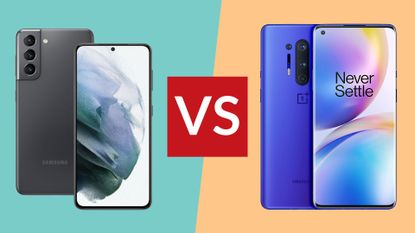Samsung’s Galaxy S21 is an excellent phone, but so is the OnePlus 8 Pro: in fact, we thought it was the best, most well-rounded phone from OnePlus in 2020. But now Samsung's had some crucial extra time to polish up and release its competitor.
So how do the two firms’ flagship phones compare – and more importantly, which one should you buy? These may be among the very best Android phones you can get – and are among the best phones of all kinds, no doubt – but there are some significant differences between them.
We'll walk you through the key areas, so it's easier to choose which is worth your cash.
Samsung S21 vs OnePlus 8 Pro: Design
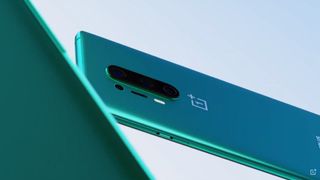
The Samsung Galaxy S21 is an evolution of the familiar Galaxy design with an edge to edge Infinity display and a hole-punch design for the front-facing camera. The standard model gets a plastic back but the more expensive Plus and Ultra are aluminium. Your colour choices are white, pink, violet or grey.
The OnePlus Pro 8 looks very like the previous Samsung, with very similar curves, an edge to edge display and a hole-punch design for the selfie camera. Here it’s on the left of the display. The rear is quite Samsung-y too, with a vertical camera assembly centred in the top third of the case. We think it looks best in Glacial Green but you can have it in blue or black if you prefer.
Samsung S21 vs OnePlus 8 Pro: Display

The Samsung Galaxy S21 has a 6.2-inch FHD display. Samsung actually dropped the screen specification compared to its predecessor: pixel density is down from 563ppi to 421ppi and the resolution is 2,400x1,080 pixels. Should still be plenty detailed enough for most people. It’s an OLED display with up to 120Hz refresh rate and is certified for HDR10+. It's absolutely one of the best screens on the market.
The OnePlus 8 Pro display is bigger at 6.78 inches, and it’s more dense too: pixel density here is 513ppi and the screen resolution is 3,168x1,440 pixels. It’s an AMOLED display with up to 120Hz refresh rate and it too is HDR10+. The 8 Pro's screen has been blowing people away since its launch – it's right up there with the best ever, including the iPhone 12 Pro.
Samsung S21 vs OnePlus 8 Pro: Performance & storage
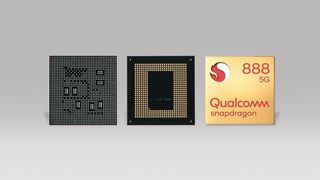
The Galaxy S21 has a Snapdragon 888 in the US, China and Korea, and it has Samsung’s new Exynos 2100 in all other markets. It’s accompanied by 8GB of RAM 128GB or 256GB of internal storage. There’s no microSD card slot for additional storage.
Both processors offer eight cores of performance, and Samsung says the new Exynos and its GPU deliver over 30% better performance and 40% better graphics performance than the previous model. The Samsung Galaxy S21 runs Android 11 with Samsung's own One UI 3.1, which is great-looking.
The OnePlus 8 Pro has OxygenOS, which is based on Android 10. The processor is a Snapdragon 865 with Andreno 650 graphics, 8GB or 12GB of RAM and 128GB or 256GB of storage. This is slightly behind the Snapdragon 888 in the S21, though you'd only notice in the most intense tasks (high-end image editing, say) – in the general use, both are extremely smooth and quick.
Samsung S21 vs OnePlus 8 Pro: Cameras
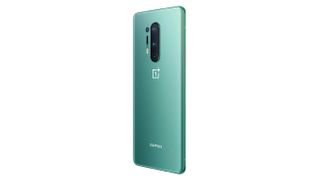
The Samsung S21 has three rear cameras, with 64MP telephoto, 12MP wide angle and 12MP ultra-wide angle cameras. It has 3x hybrid zoom, 30x digital zoom and optical image stabilisation (OIS). It can shoot 8K video at up to 24fps, or 4K video at up to 60fps. The front-facing camera is 10MP.
The main rear camera on the OnePlus is 48MP with optical and electronic image stabilisation. There’s also an 8MP telephoto, 48MP ultra-wide angle and a 5MP colour filter lens. The rear camera setup has 3x hybrid zoom and can record 4K video at up to 60fps. The front-facing camera is 16MP.
Samsung S21 vs OnePlus 8 Pro: batteries and charging
The battery in the Samsung Galaxy S21 is 4,000mAh. It supports 25W fast charging, 15W wireless charging, 4.5W reverse wireless charging and USB Power Delivery 2.0. You don’t get a charger in the box – just a cable – so be sure to buy one with a high enough power rating to support fast charging, if you want to use it.
The OnePlus 8 Pro battery is 4,510mAh with Warp Charge 30W fast charging and 30W wireless charging. A charger is included in the box (along with a screen protector, a sticker sheet and a case). The battery has significantly more capacity than the Galaxy S21, but then it has to power a larger screen and slightly older processor (so is slightly less power-efficient).
Samsung S21 vs OnePlus 8 Pro: Price and verdict
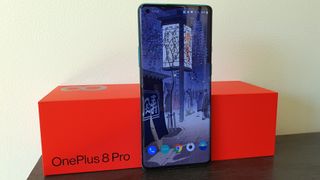
The Samsung was priced very aggressively at launch, at $799/£769 /AUD$1,249, compared to the OnePlus Pro's $899/£899/AUD$1,500.
The OnePlus has a bigger, higher resolution display and a bigger battery, and you won’t need to hunt for a charger or shell out for a case. But for a little less the Samsung has a slightly faster and newer processor, better graphics performance and a higher megapixel rear camera.
However, while the Samsung’s Exynos beats the OnePlus’s Snapdragon in most benchmarks, the exception is in gaming. That’s because developers often optimise for Snapdragon processors. The combination of better gaming benchmarks and a bigger, sharper screen means for gamers at least, the OnePlus may be the better buy.
For everyone else, they're very much equal – the newness of the Samsung (with its more advanced processor and newer version of Android) means it may be the one that lasts the best for your investment… but then if you want a bigger screen, you certainly won't be unhappy with the OnePlus.
